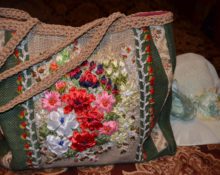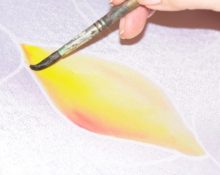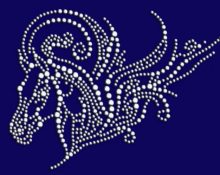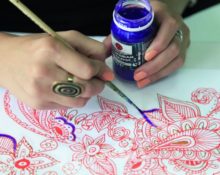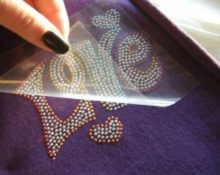You can change your favorite denim without altering it. The clothes will remain comfortable, but a few creative details will emphasize individuality and add completeness to a fashionable look.
Pieces of denim can be recut and re-glued like paper. You can also paint it, tear it in the right places, mix it with another fabric, or assemble a new thing from stripes and shapeless shreds.
Since the advent of the signature “arched” stitching (for a moment, 1873!) Levi Strauss’ indigo-colored work denim clothes have been occasionally used in everyday life. After World War II, young people began to pay attention to denim clothing, and at the end of the 20th and beginning of the 21st centuries, the talented hands of designers turned sometimes rough fabric into a rare work of textile art.
How to freshen up a denim item
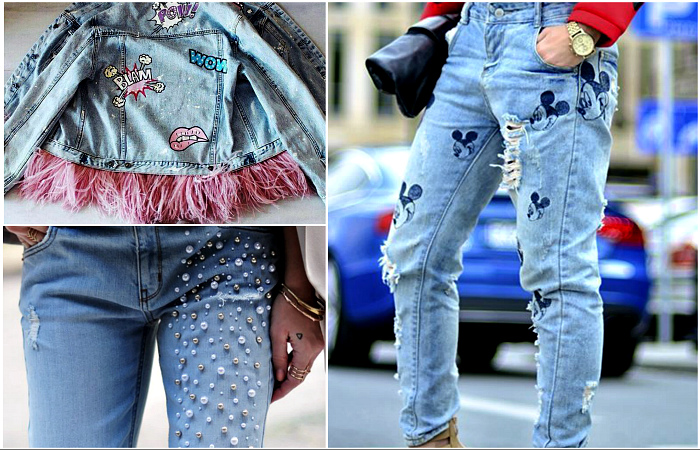
Combination of denim and:
- python skin;
- fur;
- rhinestones;
- Silk embroidery adds a touch of luxury. Suitable for lovers of the Boho style.
Denim clothing decorated with chains and spikes will appeal not only to rockers.A few metal details on skinny girls' jeans will emphasize their fragility.
Holes, abrasions, and multi-colored stains on denim clothing become an accent in urban clothing. And the combination of traditional cross-stitch and rigid fabric will appeal to adherents of the “ethno” and “country” styles.
Embroidery
Embroidery looks good on denim. The embroidery machine will need stabilizing fabric and special threads. Ordinary sewing shops do not embroider (unless the owner knows how to stitch with the machine running freely), but manufacturers offer decorative and finishing stitches to choose from. If you stitch with colored thread and a double or triple needle, you will get an interesting design.
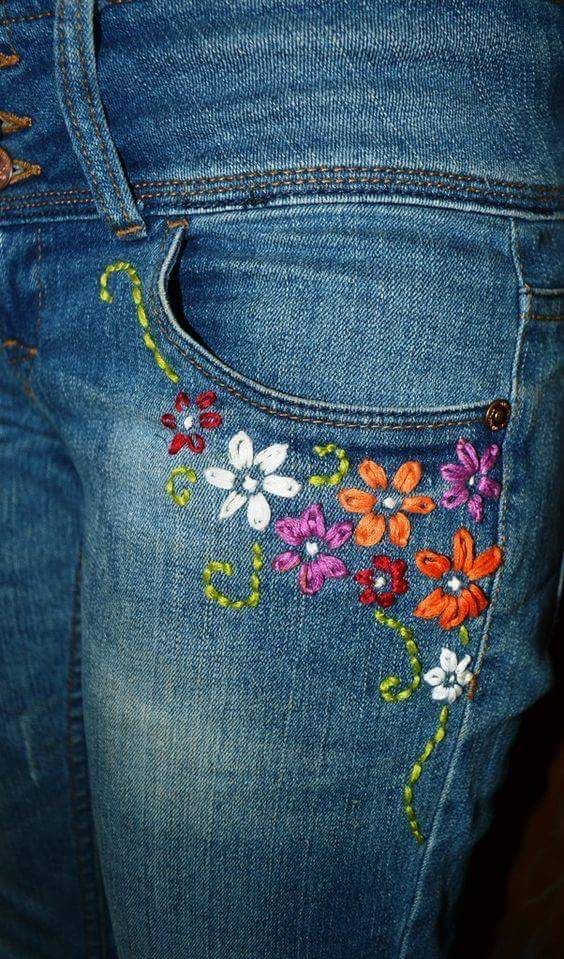
Weave denim threads are not suitable for warp. Therefore, for embroidery, a canvas is used, which is placed on top. At the end of the work, the threads are pulled out or carefully cut, closing the ends, for example, with a chain stitch.
Water-soluble canvas is sold in narrow strips. If the embroidery covers a small area, one leaf is enough.
Embroidery with beads, pallets and beads revives even an old thing. There is a wide range of different colors and shapes on sale. Beads are usually sewn onto fabric using a backstitch; beads can be strung on a thread and sewn in a zigzag pattern on a sewing machine using a bead foot.
Advice. Use grandma's jewelry. Often these products contain high quality beads and beads.
Applique, stripes
The assortment in sewing supply stores allows you to choose from funny “cartoon” designs to military-themed patches. Usually this is an embroidered piece of fabric without an adhesive surface.
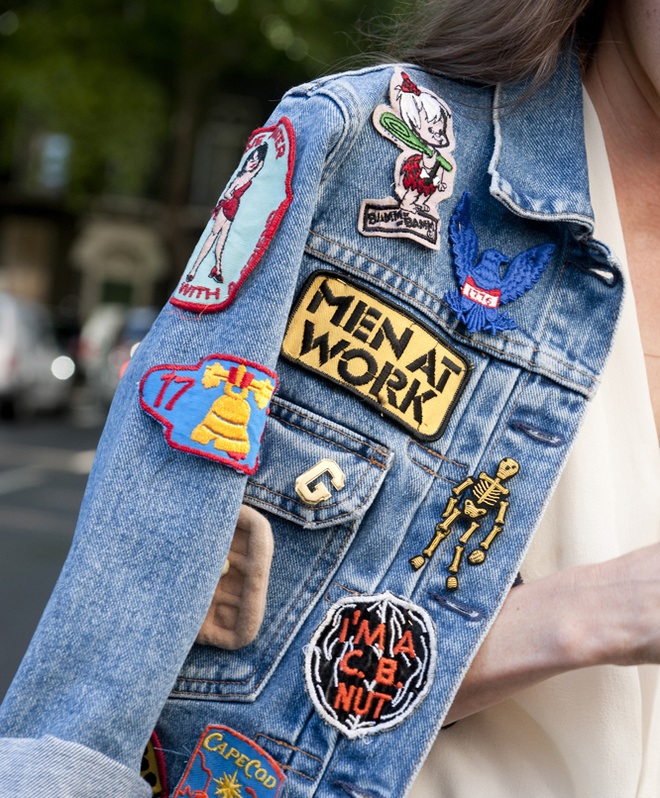
In this case, it is basted and then sewn on by hand or on a sewing machine.
You can use any fabric for decoration. It is glued to the thermo-adhesive non-woven fabric with an iron, cut out and glued to the denim, having previously removed the protective layer. In this case, there is no need to sew the applique along the edge.
By the way. The more stripes that partially overlap one another, the more interesting it is.
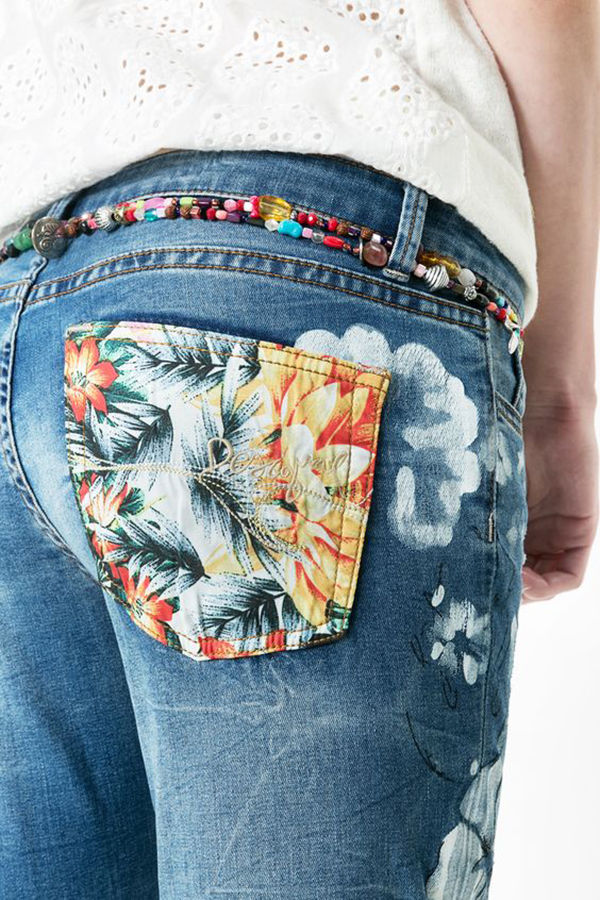
Rhinestones
Rhinestones are a simple option for decorating jeans. For gluing you will need tweezers, an iron and adhesive tape (painting tape will do). Technical tape is not used due to its strong adhesive base.
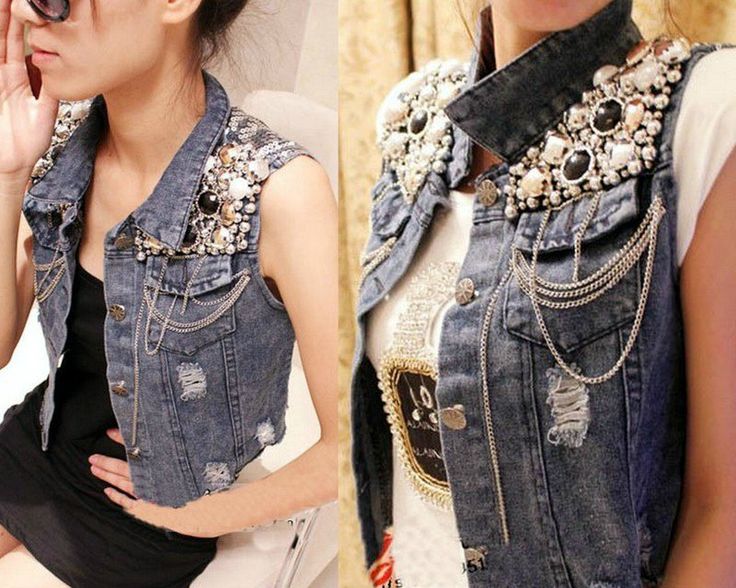
- Clean and ironed clothes are laid out on a flat surface. Using chalk and washing-up soap, apply the outline of the design. Then the rhinestones are laid out.
Attention. A colored fabric marker (or pencil) usually disappears after washing (or a few days after application). If you plan to “walk” the new thing right away, they don’t use such tools.
- The backing (matte part) of the thermal adhesive tape is removed, and the lined rhinestones are covered with the transparent sticky part. Correct the displaced “glasses” using tweezers.
- The film with rhinestones from below is covered with a matte part, making a “sandwich”, where the rhinestones are located between pieces of adhesive tape.
- The structure is heated at a low altitude with a heated iron (turn off the steam!), without touching the surface.
- The backing is separated, the film with rhinestones is placed on the fabric and pressed well.
Advice. Use a book wrapped in 2 layers of pillowcase.
- Iron the clothes from the wrong side for 30-40 seconds. (“cotton” mode), pressing the iron firmly.
- Carefully remove the adhesive tape.
Items decorated with rhinestones can be washed in cold water (30 g) with a slight spin.
Spikes
Metal blocks, silver and yellow thorns (less often colored) are attached to the fabric using the same method as rhinestones, using an iron.
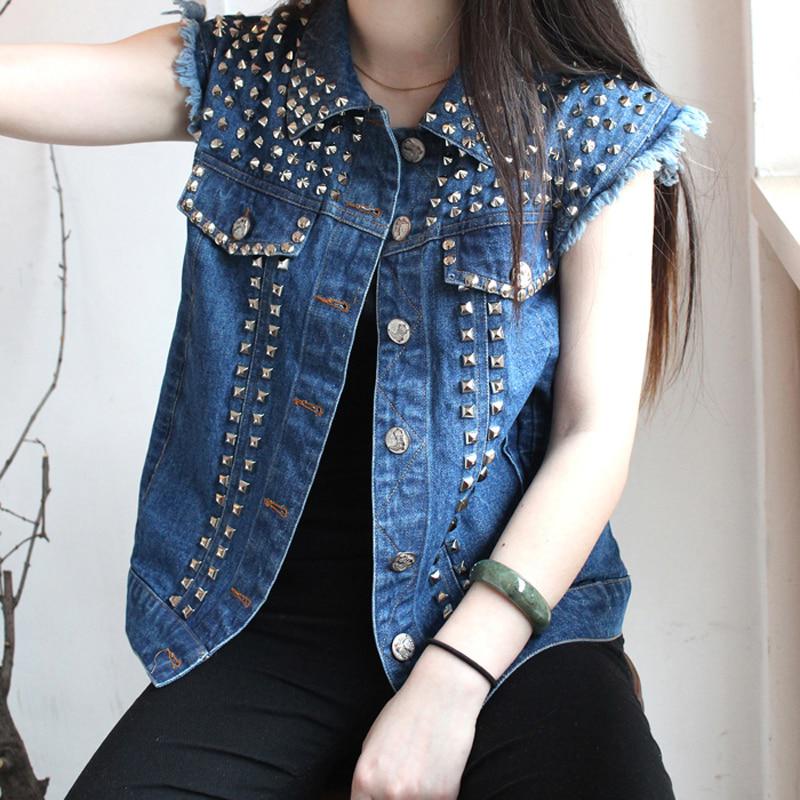
If, according to the model, the spikes are attached to the sleeves (without cuffs) or trouser legs, to make the edges rigid, they are folded, stitched with a “blind” seam or on a sewing machine: a foot for hemming the bottom of trousers is well suited for this.
Spikes and blocks look interesting in geometric patterns. For accurate drawing you will need graph paper. To prevent the adhesive part of the metal decoration from sticking to the paper, a transparent acetate film is placed between the graph paper and the blocks. And then, using adhesive tape, the decorations are glued on like rhinestones.
When metal spikes are screwed onto a thin denim base, dublerin is glued under the bottom of the denim. Then the spike on the finished product will stick out, and not hang down with its point down.
Advice. If there is a special punch, eyelets or clips are used for decoration.
Chains
For decoration, separate links of the chain are sewn on, leaving the middle or the second end hanging freely. An interesting option: lay out a pattern in a chain, and then sew on each link.
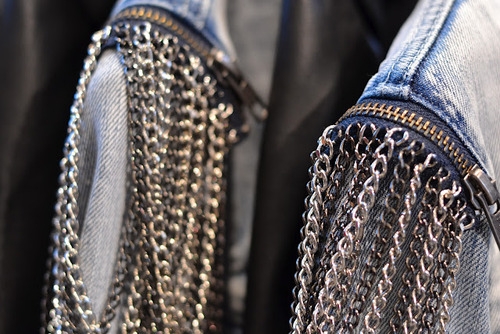
Holes, abrasions
Holes and abrasions are suitable for worn items: soft fabric lends itself well to processing.
For holes, the fabric is cut, and then the edges are scratched with a fork, and some of the threads are removed. In this way, part of the warp threads is left.
Advice. Use fabric with a contrasting pattern as a backing under the hole.
Abrasions are obtained by treating the surface with sandpaper. For convenience, a piece of sandpaper is wrapped around a wooden block, which is passed over the surface.
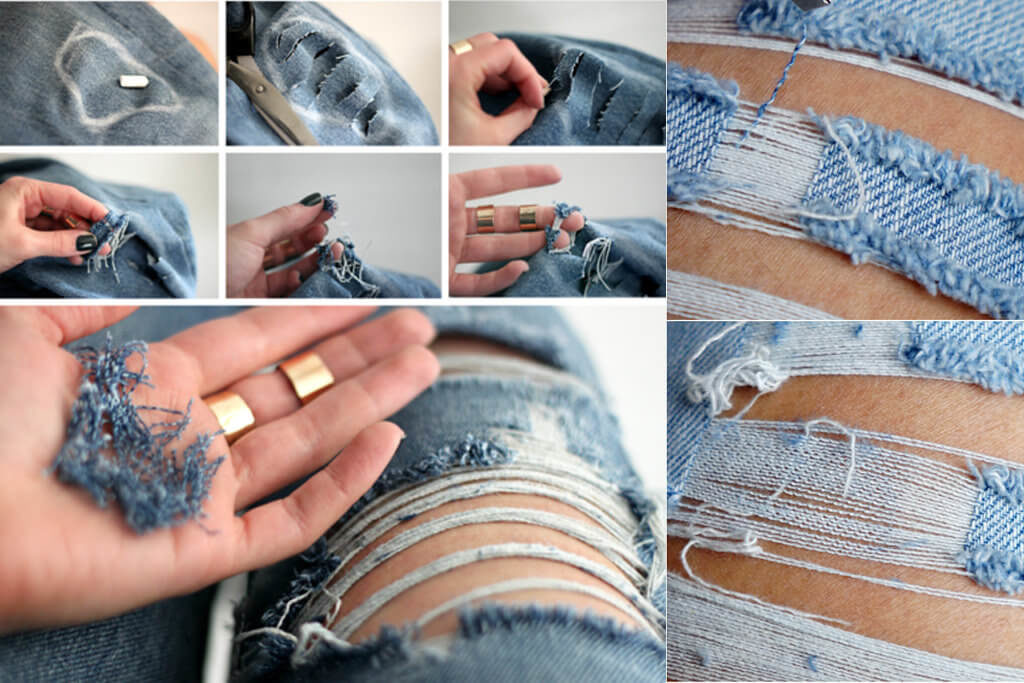
Painting
The traditional method of decorating denim is dyeing. Metallic or topcoat inks look best on denim.To apply the design, use a brush, stencil or spray bottle.
Of course, you can simply buy fabric paint, pour it into a basin, dissolve it in warm water and then follow the instructions. More original things are obtained by tying knots on denim, twisting and folding the item. Then after painting you will get a “varenka” stylization.
For painting on denim, choose metallized or topcoat paints. The design is applied using a brush, stencil or spray gun.
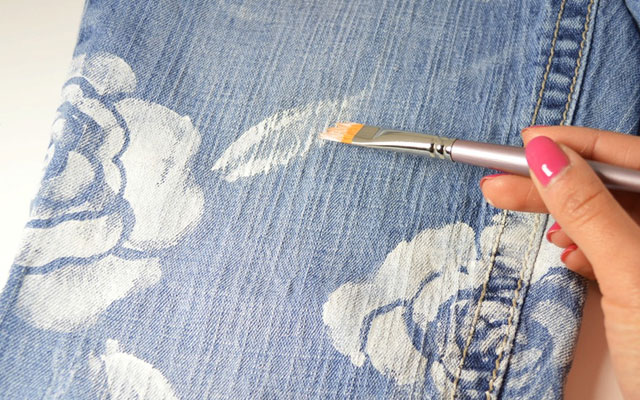
First, a template is made from paper. Then the design is outlined on the fabric with a light pencil and the outline for the ground of the future design is filled in with topcoat white paint. Leave to dry for an hour.
Paint the drawing with a brush. After drying, tints are applied, adding depth to the image. When the paint is completely dry, iron the denim from the wrong side.
When using a stencil for a design, it is first secured with adhesive tape. Then apply paint from the outside to the center in a circular (!) motion. After drying, the item is ironed from the inside to secure it
Attention. For stencil painting, brushes with a flat working surface are used.
It is unusual to use guipure as a stencil base. Denim clothing is covered with fabric and then painted through the outer fabric. You can also use waterproof markers.
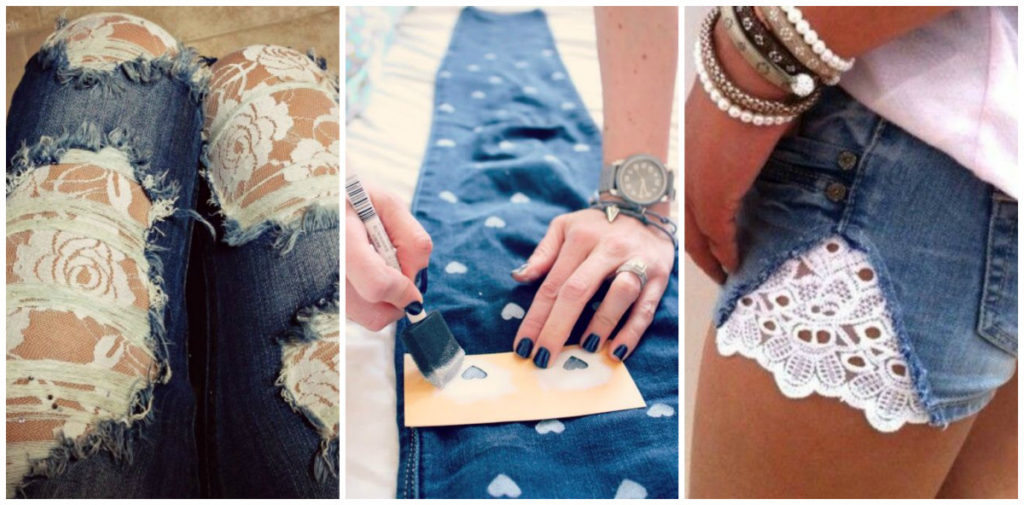
Pearlescent paints in small tubes are used for small designs: hearts, stars, droplets. Squeeze out of the tube directly onto the fabric, leaving to dry for up to 8 hours. During this time, some of the paint will be absorbed by the fabric, so if you are decorating a finished item, use unnecessary fabric between the layers. The finished drawing is less convex, but acquires a bright shine.
Dimensional fabric paints work differently.The paint is also applied directly to the fabric (it is better to first draw a sketch on the fabric). Leave to dry for 10 hours. Then a hot stream of air from a hairdryer is used to warm up the design from a close distance. For a more voluminous effect, you can place the denim item in the oven for 4-5 minutes. (temperature in the oven no more than 180 degrees).
Advice. The design can be baked on baking paper and glued to the fabric with special glue.
It is interesting to use hot-melt paint as a permanent or temporary decoration:
- large palette of colors;
- paint is squeezed out of a pointed tube for fine lines, a brush is used for a large area.
You will also need a clear plastic sheet (file folder covers are suitable).

The motif for decoration is first drawn on paper, but you can use a finished image in a magazine or on fabric.
- Transparent plastic is placed over the image.
- Paint along the contour, leaving to dry for 2 hours.
- Paint the inside.
- After 4-6 hours (depending on the thickness of the applied paint layer), the painted element is separated from the plastic and applied to clothing.
- Iron (steam off!) through baking paper (no oil!).
- Press with an iron for 15 seconds, then check the adhesion strength.
Clothes decorated with elements made of hot-melt paint can be washed in a washing machine at a temperature not exceeding 30 degrees.
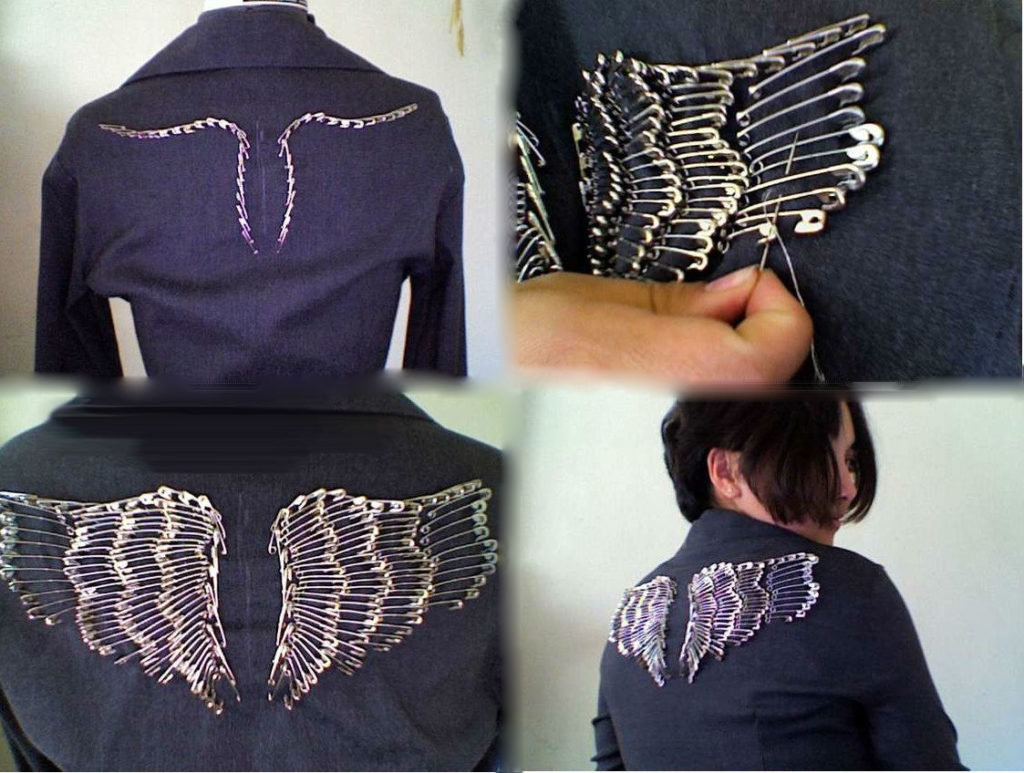
In addition to working with paint, you can decorate denim clothes with paper napkins using the decoupage technique. You will need thermo-adhesive interlining, fabric glue, and napkins for decoupage.
- For work, use the top layer with a pattern (it must be carefully separated from the napkin).
- On the reverse side, non-woven fabric is applied to the design and ironed without steam. After cooling, the design is cut out.
- Remove the protective layer of silicone paper from the back of the non-woven fabric. Apply to clothing and iron.
- To ensure that decorated clothing can withstand washing, apply a layer of glue over the design and leave to dry.
Advice. For the first time, choose a large picture: it’s easier to work with.
What styles and items are suitable for updating
There are no restrictions here. You may have to combine the clothes with another fabric, cut out a lining or a new part, but anything is suitable for creativity.
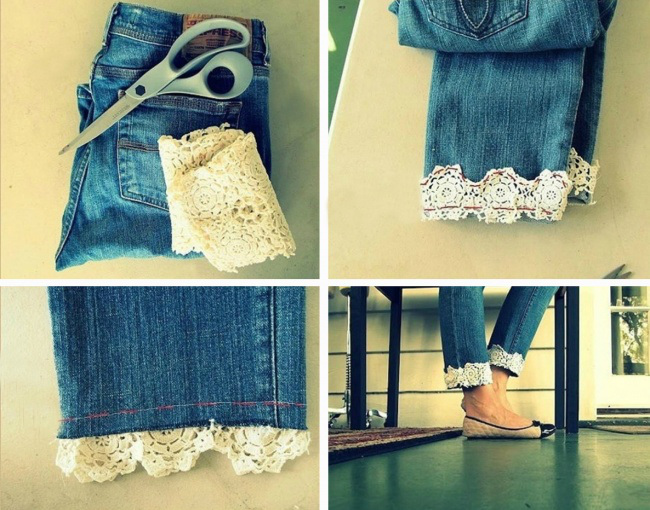
For example, the basic item already has rivets and fringes - and the owner categorically does not like this:
- excess parts are cut out or torn off;
- rivets can be removed with pliers or solvent (don’t forget to check on a piece of denim so as not to ruin the item).
When the jeans are worn between the legs, there will of course be some minor repairs needed to strengthen the pieces. After all, fashionable holes are not needed in this place.
Attention. Imitation of dilapidation is in fashion, but not dilapidation itself. Therefore, worn-out items are not suitable - you will not have such a stylish look.


 0
0